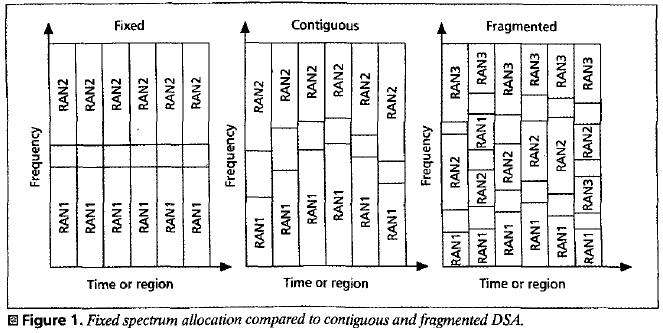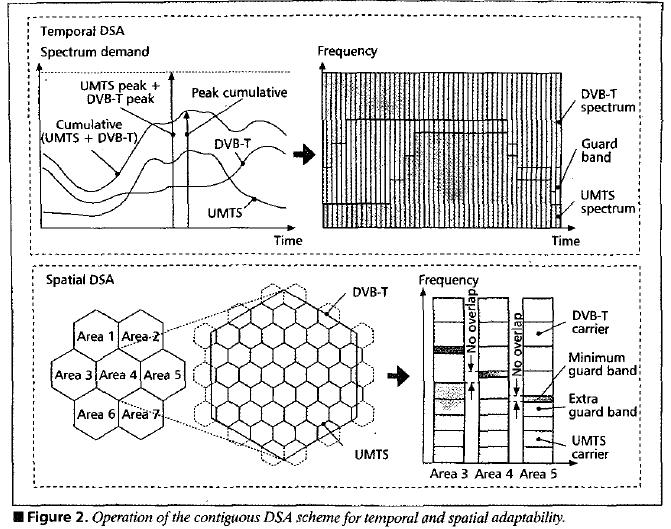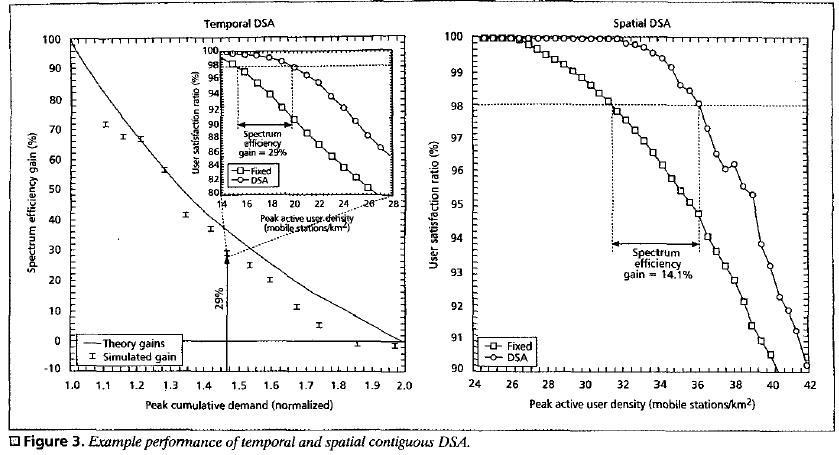Home > Dynamic Spectrum Allocation
REGUIATORY INTEREST IN
DYNAMIC SPECTRUM ALLOCATION :
Spectrum is a national resource, and consequently
national regulators have the responsibility
to ensure economical use of a society’s
spectrum resources. The governments coordinate
the development and standardization of
radio communication networks and services
within the International Telecommunications
Union - Radio communications Standardization
Sector (ITU-R). At present, the Radio Regulations’ frequency allocations differ depending on
the region (Europe, North America, Asia, etc.),
and are segmented into precisely defined categories
of services (e.g., fixed, mobile, broadcasting,
and radiolocation). The convergence of
services and growing development of applications
based on a combination of two or three
services among fixed, mobile, and broadcasting,
raises the issue of simplifying the regulatory
framework to adapt to this new situation .
At the World Radio Conference (WRC)
2000, Resolution 737, “Review of Spectrum and
Regulatory Requirements to Facilitate Worldwide
Harmonization of Emerging Terrestrial
Wireless Interactive Multimedia (TWIM) Applications,”
invited the ITU-R to evaluate the
necessity to identify spectrum for TWIM, and to
review regulatory methods and service definitions.
In light of Resolution 737 an ITL-R Joint
Task Group was formed and defined the scope
of TWIM as “applications in one or more of the
Mobile, Fixed and Broadcasting Services that
are capable of supporting hi-directional exchange
of information of more than one type (e.g.,
video, image, data, voice, sound, graphics)
between users or between users and hosts.”
TWIM was discussed at WRC 2003 and suggested
as an agenda item for WRC 2010; further
studies will be done until that time. There is also
a new resolution for “options to improve the
international spectrum regulatory framework”
from WRC 2003, which proposes “to examine
the effectiveness, appropriateness and impact of
the Radio Regulations, with respect to the evolution
of existing, emerging and future applications,
systems and technologies, and to identify
options for improvements in the Radio Regulations.’’
This demonstrates international awareness
that thc convergence of radio systems and
services will have a significant impact on the way
spectrum is regulated.
Discussions have also started on a national
level. For example, an independent review of
spectrum management commissioned by the
U. K. government states that “spectrum trading
should be implemented in the UK as soon as
possible.” In addition, it says “broadcasters
should be given the ability to lease spectrum to
other uses and/or users.” Outside Europe, the
U.S. Federal Communication Commission
(FCC) Spectrum Policy Task Force has taken a
proactive role in recognizing the potential for
new regulation mechanisms to be an important
mechanism to allow the modernization of spectrum
engineering practices to improve spectrum
efficiency. A report from the Spectrum Policy
Task Force states that “preliminary data and
general observations indicate that many portions
of the radio spectrum are not in use for significant
periods of time, and that spectrum use of
these ‘white spaces’ (both temporal and geographic)
can be increased significantly.” These
regulatory developments show that there is a
perceived need to bring regulations up to date,
and these fit well with the DSA concepts presented
here. However, significant changes in regulations
would still be required in order to roll
out even simple DSA schemes.
World Radio Conferences are scheduled only
every three to four years with the scope of the
agenda established four to six years in advance.
Hence, the regulatory process is slow and not
tailored to cope with rapidly changing needs.
For example, the 3G spectrum had to be allocated
more than 10 years ago, when it was still
unclear what 3G would be.
METHODS FOR
DYNAMIC SPECTRUM ALLOCATION :
The term dynamic spectrum allocation can potentially
cover a range of different subject areas.
Several established research fields are related to
DSA, such as dynamic channel allocation
(DCA), frequency assignment, unlicensed spectrum
access, and spectrum coexistence.
If we are considering only a single radio network,
the concept of DCA is very close to that
of DSA. DCA shares the available radio
resources among thc base stations of a radio
access network (RAN), and many different
schemes have been suggested in this widely researched field. The area of frequency
assignment has also been studied for many years
. The idea behind frequency assignment is to
develop techniques for finding the optimum
assignment of frequencies to radio access nodes
(e.g., base stations) in order to meet interference
and coexistence constraints. However, we are
more interested in methods that allow different
radio systems with differing characteristics (e.g.,
broadcast,multicast,unicast, different overlapping
cell sizes, various supportable serviced data
rates) to dynamically share a set of radio
resources between the networks in a composite
radio environment scenario.
A very relevant and active research area is
unlicensed spectrum access. If the spectrum
is unlicensed, it is treated as an open resource
any conforming device can use. However, this
may not be suitable for all scenarios (e.g., where
multimedia and delay-sensitive services need to
be delivered). Another method of sharing the
radio spectrum is to allow different networks to
coexist within the same radio spectrum. This is
operating successfully today, for example, with
the peaceful coexistence of digital and analog
TV transmissions in the same hand, and can be
extended to consider the coexistence of totally
disparate networks through close consideration
of their frequency plans .
Given that there are schemes for cell-by-cell
control and optimization of the radio spectrum
for single networks (e.g., DCA and frequency assignment), and also ones that apply little or no
control over the systems (e.g., unlicensed access
or coexisting systems), we aim to focus on
schemes between these two extremes. It must be
remembered that we are specifically looking at
schemes that share the spectrum between multiple
disparate networks in a composite radio system,
and we aim to share the spectrum between
the networks at a RAN level, rather than with
cell-by-cell coordination. We therefore concentrate
on methods for permitting two or more
networks to share an overall block of spectrum
so that spectrum allocations can adapt to either
temporal or spatial variations in demand on the
networks.
Two schemes to consider are shown in
Fig. 1, contiguous and fragmented DSA. These types of scheme have been investigated of scheme have been investigated within the European projects DRiVE, OverDRiVE
and TRUST .

Contiguous assignment uses contiguous
blocks of spectrum allocated to different RANs,
and these are separated by suitable guard
hands, much as in fixed assignment. However,
the width of the spectrum block assigned to a
RAN varies in order to allow for changing
demand. This scheme will only allow the spectrum
partitioning of a RAN to change at the
expense of the spectrally adjacent RANs spectrum.
Therefore, if a RAN wishes to increase
its allocated spectrum, it will not be able to do
so if the spectrally adjacent RAN will not
release the spectrum, raising fairness issues.
However, this still provides a scheme for allowing
spectrum to be used by other RANs if it is
not being fully utilized.
The second technique is called fragmented
DSA. With this scheme, the spectrum to be
dynamically allocated is treated as a single
shared block, and any RAN can be assigned an
arbitrary piece of spectrum anywhere in this
block. This is advantageous if more than two
RANs are sharing the spectrum, as the contiguous
scheme can be restrictive in these cases. The
main disadvantage with this scheme is that it
becomes more difficult to control, particularly in
terms of interference. This technique can potentially
have many guard hands throughout the
shared spectrum, and it therefore becomes very
important that these be minimized and kept as
small as possible, without compromising interference
conditions.
OPERATION OF CONTIGUOUS DSA :
As an example of the performance of a DSA
scheme, we look at the operation of the contiguous
DSA method described above. We consider
the scenario of a converged cellular and
broadcast system, for example, utilizing the
Universal Mobile Telecommunications System
(UMTS) 3G cellular network, and the digital
video broadcasting terrestrial (DVB-T) network.
These, operating in a composite radio
system and working together to deliver a mix of unicast and multicast services to users, provides
an ideal scenario for DSA operation. The dominant
services over each of the networks (voice
telephony over UMTS, video over DVB-T)
determine the temporal and spatial load
demands seen on the networks, and provide the
variations required for DSA.

TEMPORAL DSA :
An example of how a temporal DSA scheme
may operate can be seen in Fig. 2. This shows
curves of how the loads may change on the different
networks over time, and how this can correspond
to changing spectrum partitioning. By
comparing the amount of spectrum required for
fixed allocation (given hy the sum of the largest
demands on the RANs, and labeled "UMTS
peak + DVB-T peak") with the amount required
for DSA (given by the peak cumulative demand),
we can find the extent to which the traffic can be
increased with DSA to give the same user satisfaction
in the same spectrum as fixed allocation.
This gives us an ideal theoretical value for the
spectrum efficiency increase. This can be calculated
for any set of traffic patterns like those in
Fig. 2, and allow for interesting comparisons
with algorithms developed to implement temporal
DSA.
Several implementations of an iterative, realtime,
temporal DSA algorithm are possible, hut
typical steps in the operation of the temporal
DSA algorithm include:
1) Periodic triggering of DSA algorithm:
Depending on the traffic patterns, typical
timescales could be in the order of tens of minutes
to several hours.
2) Management of the trafic on the carriers:
This can include packing calls into carriers, locking
off carriers from accepting new calls, or
selectively dropping calls from the carriers. This
ensures that as many carriers as possible can be
released for reallocation hy DSA.
3) Prediction of the loads on the networks:
Since the DSA algorithm runs periodically, and
not on a call-by-call basis, the traffic demands
can change significantly during the DSA period.
Prediction can be used to allocate spectrum
according to the demands that are expected over
the whole interval. Prediction schemes can be
based on load-histories of past traffic, and timeseries
estimation algorithms.
4) Allocation decision: From the predicted
loads, combined with the current allocations and
the amount of spectrum available for reallocation,
an algorithm can decide the allocations that
will be applied for this interval. These algorithms
have important implications for the performance
and fairness of the DSA schemes.
A typical DSA simulated erformance curve
can be seen inset in the left curve of Fig. 3,
which shows the performance for the overall system
of UMTS and DVB-T for both fixed and
dynamic assignment with the time varying traffic
patterns from Fig. 2. The spectrum efficiency
gain of 29 percent is measured as the increase in
load supportable at 98 percent user satisfaction.
Simulations can be performed for a range of
traffic patterns (characterized by the value of the
peak cumulative spectrum demand) and compared
to the theoretical results. This can be seen
in the main graph on the left side of Fig. 3. The
comparison highlights several factors that affect the performance of the implemented DSA
schemes. These include issues such as the overall
amount of spectrum available, and to what
degree it is quantized into carriers, the time
interval between reallocations, the accuracy of
the load prediction, and the readiness of the
RANS to free up carriers for reallocation by the
DSA algorithm. SPATIAL DSA :
For the spatial DSA example, we consider the
same composite radio system as the temporal
case, except we wish to adapt the spectrum allocations
to the regional demands on the networks
for a given time. The regional adaptations cannot
be performed with arbitrarily fine spatial resolution,
and areas of uniform spectrum
allocation must be defined, called DSA areas.
These should correspond to regions where the
traffic demands of the RANs are relatively constant
in space. The formation of the DSA areas
in this scenario can be seen in Fig. 2, where the
size of the area corresponds to a single DVB-T
cell. Larger areas are also possible, comprising
multiple DVB-T cells.
The goal of spatial DSA is to allocate spectrum
to RANs according to the traffic demands
in each DSA area. Furthermore, it is necessary
to coordinate the spectrum allocation between
adjacent DSA areas to avoid interference. In
particular, the spectrum allocations of different
RANs belonging to adjacent DSA areas should
not overlap in the same portion of spectrum. In
order to avoid this spectrum overlap while still
allowing spectrum allocation adaptation to the
traffic demand, the guard band needs to be
increased to guarantee the coexistence of the
different systems, as can be seen by the example
allocations shown for the areas in Fig. 2. The
extra guard bands represent a critical issue for
spatial DSA, since it has to consolidate the need to satisfy the spectrum requirements with the
necessity to limit the guard bands to the minimum
possible.
The structure of an example spatial DSA
scheme can be summarized in three main steps:
1) Calculate the spectrum overlap: In each
DSA area this is calculated on the basis of the
spectrum requirements of the RANs in its adjacent
areas. This operation allows a first estimation
of the size of the guard hand in each DSA
area, and therefore sets a limit on the portion of
allocable spectrum.
2) Perform initial assignment: On the hasis
of these limits, calculated for each DSA area, a
first spectrum assignment to each RAN can be
performed, such that the overall number of satisfied
users is maximized.
3) Optimization: After this spectrum assignment,
actual spectrum overlap is identified and
then eliminated, reducing spectrum allocations
where needed.
The right curve of Fig. 3 shows the performance
of the overall system of UMTS and DVB-T
for both fixed and dynamic assignment. An
increase of 14 percent in spectrum efficiency is
shown when DSA is used over fixed allocation,
in this example scenario.

|
